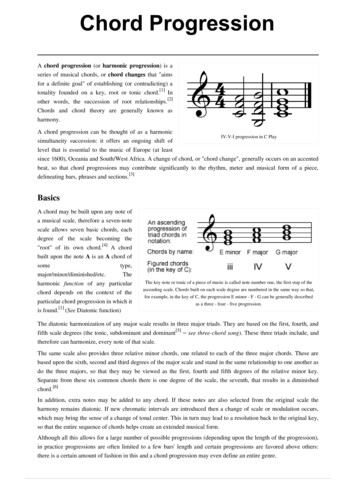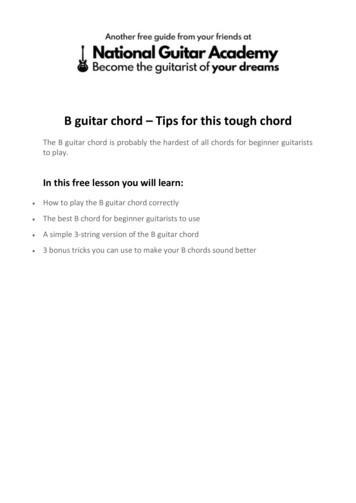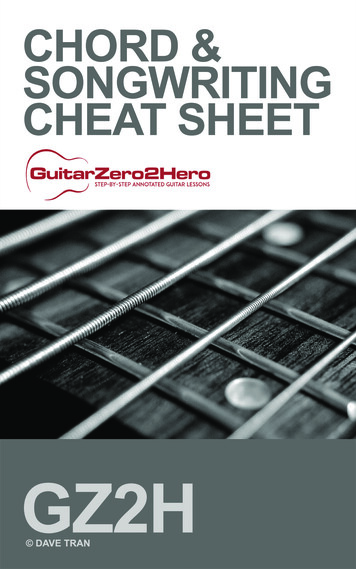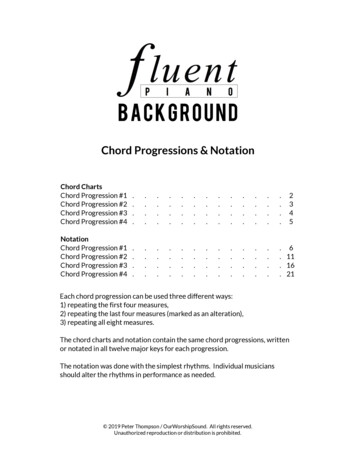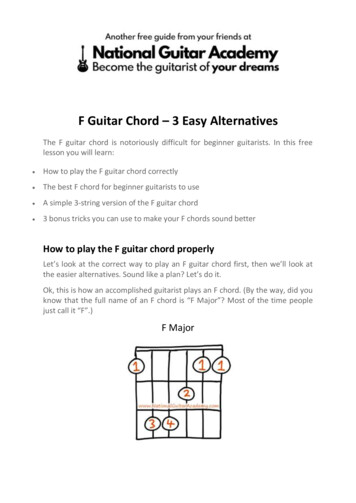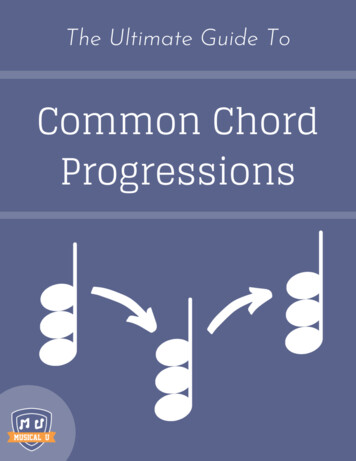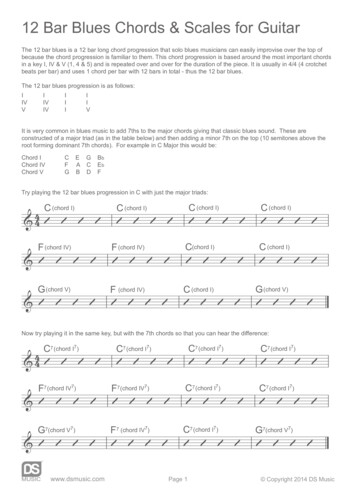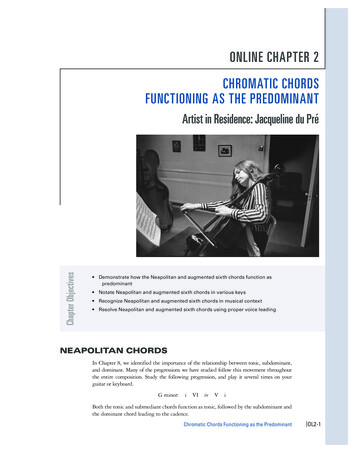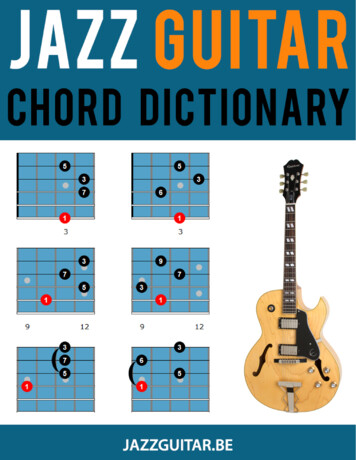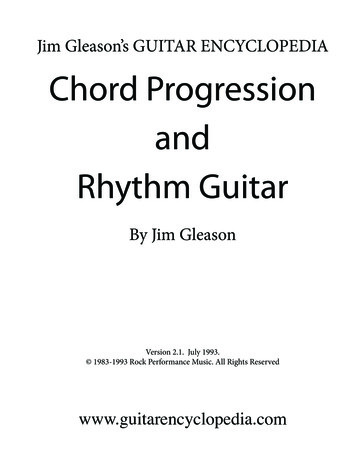
Transcription
5 Powerful Chord ProgressionIdeas To Enhance Your SongwritingSongwritingLessonsOnline.com
5 PowerfulChord Progression Ideas ToEnhance Your SongwritingBy Ryan Buckner Guitar Mastery Solutions, Inc.2
Songwriters are always looking for new and interestingchords to use to enhance their music. Although it iseasy to simply do a quick search online to find manychord progressions that you can try in your music,there do not exist many sources that actually explainWHY certain chord progressions work the way they do.With this eBook, my intention is to not only give yousome interesting chords to try out in your music, but toalso educate you on how they are generally used inmusic so that you can get a better perspective forunderstanding how to use them in your own songs.All of the ideas discussed in this book can be used forany instrument and for any musical style. In order toget the most out of the chord progression ideas I willbe discussing, I recommend that you use yourinstrument or writing software to playback each oneseveral times. This will allow you to get a better feel forhow each progression sounds. After you have donethis, think of different ways that you can tie in the feeling' of each chord progression with thoughts, ideasor emotions that you can use in your songwriting.Once you are able to use these chord progressions inyour music, you will drastically increase your optionsfor creating highly self expressive music.To understand some of the ideas discussed in this eBook it willbe helpful to understand the concept of “roman numerals.” Incase you have not read it already, check out this article onsongwriting chord progressions. Guitar Mastery Solutions, Inc.3
Progression Idea #1:Using The Neapolitan ChordThe Neapolitan chord became popular when it was used frequently by17th century opera composers in the Italian city of Naples.The Neapolitan chord is a major chord that is built off of the notethat is a half step above the first note of the key. For example, ifyou are in the key of C major (notes: C D E F G A B), theNeapolitan chord would be “Db.” In roman numerals, this iswritten as “bII.” Due to the way it sounds when used togetherwith the diatonic chords of the key, the Neapolitan chord is usedpopularly in progressions to create a sense of surprise in thelistener.Chord progressions using the Neapolitan chord commonly use aspecific formula to “set up” a cadence. A cadence is a musicalresting point. To explain a cadence, think of music like asentence in grammar. Each letter in the words of the sentence isa note, then each phrase of the sentence could be thought of aspart of a melody or chord progression. The cadence would be thefeeling of resolution you get after the “period.”Here is the common formula that is used with the Neapolitanchord: Guitar Mastery Solutions, Inc.4
1st chord: Neapolitan (predominant) - bII2nd chord: Dominant - VLast chord: Tonic - I or iThis chord can also be used directly after the I or i chord at theend of a song section to create a very distinct and surprisingending.Example:bII - V - I (Db - G - C)bII - V - I (Db - G - Cm)i - bII (Cm - Db)To add more depth to the progression, you can use additionalchord before the Neapolitan:Example:iv - bII - V7 - i (Fm - Db - G7 - Cm)bVI - bII - V7 - I (Ab - Db - G7 - C)Also, the Neapolitan chord is used often in 1st inversion. Try outthese chord progressions to see how this sounds:Example:Db/F - G7 - CmFm - Db/F - Cm/G - G7 - CmExample:Cm - Db/F - F#dim - G7 - CCMaj7 - Fmaj7 - Cmaj7 - DbMaj7Dm7b5 - G7#11 - Cm9 - Gb7#11 - F13 - Db9 - Cm9 Guitar Mastery Solutions, Inc.5
Progression Idea #2:Movement By ThirdsThird related chord progressions became a staple during Romanticera music. These types of progressions were used commonly by greatcomposers and musicians of the time such as Liszt, Chopin andBrahms. Later they would be seen in a different light by famous jazzmusician John Coltrane.Building chord progressions that advance from one chord to thenext by thirds is a way to create an interesting feel in yourmusic. By “moving by thirds”, this refers to a third (either majoror minor) away from the root of the chord you are starting on.For example:If you are beginning on the C major chord, the root note of thischord is “C”. If you want to move a third away from C you have4 options to choose from: A, Ab, E and Eb. Once you haveestablished these notes, you can turn them into either major orminor chords, giving you a total of 8 chords to choose from.You will find that each chord choice will give a very different feel'. As you move on from one chord to the next, you cancontinually cycle through different sets of chords depending onwhich ones you choose. This gives you a nearly endless amountof options to work with. Guitar Mastery Solutions, Inc.6
bVI and bIIITry beginning or ending a song section by alternating betweenthe Tonic chord in the key and either a bVI or a bIII. Here aresome examples in C major, notice the almost “dream-like”feeling of these progressions:Example:I - bVI (C - Ab)I - bIII (C - Eb)I - bVI (Cmaj7 - Abmaj7)A creative idea you can try using movement by thirds is to spellout the name of a chord as you move from one chord to thenext. For example: If you are in the key of C major, you canmove (starting on “C”) from C major up to B major/minor tospell a major 7 chord (C E G B). Here are some ways that such aprogression could be created:Example:C major - E major - G major - B majorC major - E minor - G minor - B majorCmaj7 - Em7 - Gm7 - Bm7Try spelling other chords as well such as a dominant 7 chord (C7 C E G Bb) or a minor 7 chord (Cm7 C Eb G Bb) to come upwith even more possibilities. Guitar Mastery Solutions, Inc.7
Progression Idea #3:Using Chords To Create Descending Bass LinesDescending bass lines have been used for hundreds of years to createstrong direction in music. Although there are many, some popularmodern examples that use descending bass lines include the intro to“Stairway To Heaven” by Led Zeppelin, “No Woman No Cry” by BobMarley and the bridge in “And Your Bird Can Sing” by the Beatles.Descending bass lines are the most powerful way to create asense of “falling” in music. By the nature of the way the notesdescend, this chord progression technique is also very useful foremphasizing sad feelings or the idea of feeling “down”emotionally. Additionally, it is very easy for our brains to process“linear” moving notes. As a result of being easier to follow, themusic then becomes more easily accessible (we can “get into it”faster).One way to create chord progressions with descending bass linesis to begin with the notes for the scale of the key you are writingin. For example, the A major scale contains the notes:A, B, C#, D, E, F#, G#To begin creating your descending bass line, all you need to dois arrange these notes to where they descend by letter name.Here is an example:E, D, C#, B, ANext to make your chord progression, you will need to find thechords in the key (in this case A major) that contain these notes.After you do this, assign each chord to one note. In order to giveyourself many different options, you will need to consider usingchords in inversions. For example, you may decide to use the C#note from above as the bass note for an A major chord (making Guitar Mastery Solutions, Inc.8
it A major in 1st inversion or A/C#) Here is one way to buildyour descending bass chord progression using the notes fromabove:Chords in the key of A major:A major (A C# E)B minor (B D F#)C# minor (C# E G#)D major (D F# A)E major (E G# B)F# minor (F# A C#)G# diminished (G# B D)Example:Note: EChord: A/ENote: DChord: Bm/DNote: C#Chord: A/C#Note: BChord: E/BNote: AChord: F#m/A Guitar Mastery Solutions, Inc.9
Overall Progression:A/E - Bm/D - A/C# - E/B - F#m/AIn addition, you are not limited to a “linear” descending bass linelike the one shown above. Many bass lines will alternatedescending and ascending, but overall maintain a descendingnature.For example, you might start off with a bass line like this:E, B, D, A, C#, G#, B, AYour bass lines do not always have to be “in key” as well.Although explaining the process for creating these types of basslines is outside the scope of this eBook, here is an example to tryout. Notice that this progression contains the chords from thepicture at the beginning of this section:Example:Am - E - G - D - F - E/D - A/C#For guitarists, here is the guitar tablature to match this example: Guitar Mastery Solutions, Inc.10
Progression Idea #4:Modal ProgressionsModal progressions (“modes”) have been used in western music sincemedieval times when 4 modes were used. Later during theRenaissance 2 more were added. Today we use a total of 7 modes inour music (1 of them, Locrian almost exclusively for jazz).The 7 Common Modes1. Ionian2. Dorian3. Phrygian4. Lydian5. Mixolydian6. Aeolian7. LocrianModal progressions are a great tool to use in order to create aplethora of different moods in your music. The term “mode”essentially refers to “key” (like major or minor). In fact, whenwe create a song in a major key, we are using Ionian mode.When we create a song in a minor key, we are using Aeolianmode.The topic of modes is a HUGE topic; however instead of justgiving you a bunch of progressions without context, I will brieflyexplain the main idea of how modes work here: Guitar Mastery Solutions, Inc.11
C major scale:CDEFGABCAs mentioned above, we call this scale “C major.” The reason forthis is that the notes of this particular scale all revolve aroundthe note “C”; this is why it is thought that “C” is the beginningfor this scale (thus it is in the key of C major). This same ideaapplies as well to A minor, which contains all the same notes asC major, except that the scale begins with A instead.That said, each mode corresponds with a specific starting pointin the scale. For example, you are using Ionian mode (major) ifyou center your chord progressions around the first note of thescale. If you are using Aeolian mode (minor), that means youare centering your chords around the sixth note of the scale.Assuming you are using the C major scale, here is an example ofwhich notes/chords to center your progressions around in orderto be “in” a particular mode:1. Ionian (major) - C major2. Dorian - D minor3. Phrygian - E minor4. Lydian - F major5. Mixolydian - G major6. Aeolian (minor) - A minor7. Locrian - B diminishedSo as another example using the information above, you knowthat if you use the notes of the C major scale, then you are inDorian mode if you center your chord progression around the Dminor chord. This is called “D Dorian”, after the note name. Hereis how this applies to all of the modes:C Ionian (C major):Notes: C D E F G A B CChords: C Dm Em F G Am Bdim COverall feeling: Happy Guitar Mastery Solutions, Inc.12
D Dorian:DEFGABCDChords: Dm Em F G Am Bdim C DmOverall feeling: SadE Phrygian:EFGABCDEChords: Em F G Am Bdim C Dm EmOverall feeling: Dark/mysteriousF Lydian:FGABCDEFChords: F G Am Bdim C Dm Em FOverall feeling: Light and airy or “dreamy”G Mixolydian:GABCDEFGChords: G Am Bdim C Dm Em F GOverall feeling: Happy with a twistA Aeolian (A minor):ABCDEFGAChords: Am Bdim C Dm Em F G AmOverall feeling: Sad Guitar Mastery Solutions, Inc.13
B Locrian:BCDEFGABChords: Bdim C Dm Em F G Am BdimOverall feeling: DarkWhen putting together modal progressions it is important to notethat because the “center” of your chord progressions changes foreach mode, the chords will not function the same (except inIonian and Aeolian where they are nearly the same). Tounderstand this, listen to how the “IV V I” progression (commonin Ionian and Aeolian) sounds in the different modes:“IV - V - I” Progression in different modesC Ionian (C - F - G - C)D Dorian (Dm - G - Am - Dm)E Phrygian (Em - Am - Bdim - Em)F Lydian (F - Bdim - C - F)G Mixolydian (G - C - Dm - G)A Aeolian (Am - Dm - Em - Am)B Locrian (Bdim - Em - F - Bdim)By concentrating on the 4 most commonly used modes(excluding Ionian and Aeolian), you can bring out their “moods”by emphasizing the characteristic notes of their scale:Dorian This mode is often thought of as a minor scale with a#6.Phrygian Known as a minor mode that sticks out due to itsb2. Most would recognize it as “Spanish” or “exotic” sounding.Lydian This mode is like Ionian except for the #4 note thatmakes it feel a bit ambiguous.Mixolydian Popular in blues and jazz, this mode is like themajor scale except it contains a b7.Note that the Locrian mode is rarely used since the diminishedchord is a very unstable chord to center your chord progression Guitar Mastery Solutions, Inc.14
around.A basic way to emphasize the notes for the notes mentionedabove is to simply use the chords that contain them. Forexample, if you want to emphasize the #4 in the F Lydian scaleyou can use these chords:Example:F Lydian (F G A B C D E F)Since “B” is the #4 note in F Lydian, you can use either G major(G B D)or E minor (E G B) along with the F major chord like so:F -G -F -GF - Em - G - FThe B diminished chord can also be used; however due to theway diminished chords are built, it will want to lead to the chordabove it in pitch (in this case C). This will only weaken the feel ofthe mode. For this reason, it is generally avoided. Additionally,there is no “rule” against using the other chords in the key, sofeel free to experiment with them as well.Keeping these ideas in mind, here are some additional examplesfor the remaining 3 modes:Example:D Dorian:Dm - Am - GDm - Am - C - GE Phrygian:Em - F - Em - DmEm - F - G - Dm Guitar Mastery Solutions, Inc.15
G Mixolydian:G - Dm - G - FG -F -C-F Guitar Mastery Solutions, Inc.16
Progression Idea #5:The Deceptive CadenceThere are many ways to resolve the end of a chord progression. Oneof the most interesting ways to do this is to surprise your listener byending on a minor chord in a major key.In most cases, a chord progression in a major key followslogically from Tonic (I) to Dominant (V) and back to Tonic again;however, sometimes instead of returning to the Tonic chord, asongwriter may choose to end on the minor Submediant (vi)chord. Known as a deceptive cadence, this songwritingtechnique is very surprising to the ear of the listener and has afeeling of being unresolved.' This type of cadence is highlyeffective for creating a sudden change in mood. It is verycommonly used to either end a song or song section. In caseswhere the deceptive cadence is used to end a song section, thesongwriter will many times continue into the next section usingthe key of the minor chord that was used.Here are some examples of deceptive cadences in the key of Cmajor:Example:I - IV - ii - V (C - F - Dm - G)I - IV - V7 - vi (C - F - G7 - Am)I - V - IV - vi - IV - V- vi (C - G - F - Am - F - G - Guitar Mastery Solutions, Inc.17
Am)Imaj7 - IVmaj7 - Imaj7 - Vadd6 - vi (Cmaj7 - Fmaj7 Cmaj7 - Gadd6 - Am)In addition to using the vi chord, you can also use an even muchmore surprising cadence by ending on a bVI chord (Ab in the keyof C major). This cadence has a much different feel, and canserve as a powerful musical statement at the end of a section ora transition to a new song section. Of course, it can be used inthe middle of a chord progression as well.Example:I - ii - IV - V - bVI (C - Dm/F - F - G - Ab)I - iii - vi - V7 - bVI (C - Em - Am - G7 - Ab)I - V - bVI - V7 - I (C - G - Ab -G7 - C) Guitar Mastery Solutions, Inc.18
Chord Progression IndexChord Progression Idea #1: Using The Neapolitan Chord1. Db - G - C2. Db - G - Cm3. Cm - Db4. Fm - Db - G7 - Cm5. Ab - Db - G7 - C6. Db/F - G7 - Cm7. Fm - Db/F - Cm/G - G7 - Cm8. Cm - Db/F - F#dim - G7 - C9. CMaj7 - Fmaj7 - Cmaj7 - DbMaj710. Dm7b5 - G7#11 - Cm9 - Gb7#11 - F13 - Db9 - Cm9Chord Progression Idea #2: Movement By Thirds1. C - Ab2. C - Eb3. Cmaj7 - Abmaj74. C major - E major - G major - B major5. C major - E minor - G minor - B major6. Cmaj7 - Em7 - Gm7 - Bm7Chord Progression Idea #3: Using Chords To CreateDescending Bass Lines1. A/E - Bm/D - A/C# - E/B - F#m/A2. Am - E - G - D - F - E/D - A/C# Guitar Mastery Solutions, Inc.19
Chord Progression Idea #4: Modal Progressions1. Dorian:Dm - Am - GDm - Am - C - G2. Phrygian:Em - F - Em - DmEm - F - G - Dm3. Lydian:F -G -F -GF - Em - G - F4. Mixolydian:G - Dm - G - FG -F -C-FChord Progression Idea #5: The Deceptive Cadence1. vi:C - F - Dm - G - C - F - G7 - AmC - G - F - Am - F - G - AmCmaj7 - Fmaj7 - Cmaj7 - Gadd6 - Am2. bVI:C - Dm/F - F - G - AbC - Em - Am - G7 - AbC - G - Ab -G7 - C Guitar Mastery Solutions, Inc.20
So you’ve finished reading this eBook? Here is what to donext Learn how to put a song together step by step by signing up thisfree 10 day mini towriteasongstepbystep.htmlDiscover how to put together your song lyrics with a melody bystudying and using the information in this article about writingmusic lyrics.Learn how to create better songs while analyzing your favoritemusic by reading this songwriting elements article.This e-book is under international copyrightprotection. It cannot be copied, sold, rented, loaned,or distributed in any way whatsoever, without writtenconsent of Guitar Mastery Solutions, Inc. Guitar Mastery Solutions, Inc.21
with the diatonic chords of the key, the Neapolitan chord is used popularly in progressions to create a sense of surprise in the listener. Chord progressions using the Neapolitan chord commonly use a specific formula to set up a cadence . A cadence is a musical resting point. To explain a cadence, think of music like a sentence in grammar.
